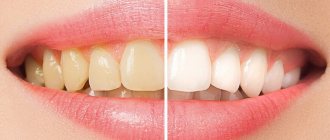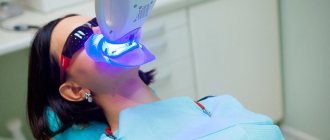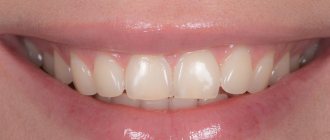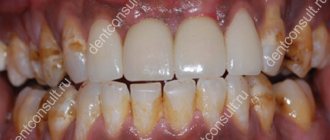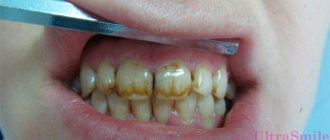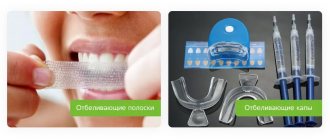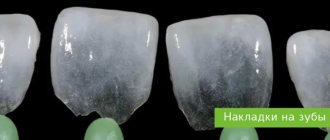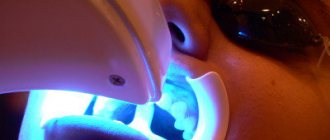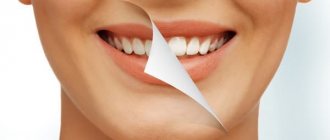From this article you will learn:
- Zoom teeth whitening technology
- How to prepare for teeth whitening
- How is the procedure performed?
- Recommendations after teeth whitening
- Harm of teeth whitening
- Whitening price
Teeth whitening in dentistry is divided into conservative and reconstructive. The latter is one in which the aesthetics of a smile is improved by filling teeth or prosthetics with veneers or lumineers. These methods are indicated when there are various stains or defects against the background of unchanged dental tissue. Conservative methods are represented by chemical, laser, and ultrasound procedures. They do not require tooth preparation or the manufacture of microprostheses, and can improve the shade of teeth by up to 12 tones.
Teeth whitening using the zoom system is a laser conservative method of enamel lightening.
With age, each person's enamel begins to darken. Also, its shade is negatively affected by the consumption of certain coloring products (coffee, tea, wine and other drinks and food with dyes), and smoking. The color of the enamel may be determined by heredity. It may be grayish or yellowish. Its color can also be affected by taking various medications, as well as intoxication with heavy metals.
If you are unhappy with the shade of the enamel of your teeth, this cosmetic flaw is harmful to your self-esteem and peace of mind, this is a fairly strong indication for teeth whitening zoom 4. It is very important to choose a good dentist, with experience - in this case, you will be given the correct preparation, the procedure itself will not will have flaws, and you will receive the right recommendations that will help prolong the effect of teeth whitening with a zoom lamp.
How to behave after the whitening procedure?
- What recommendations should you follow?
- Soreness after a session: what does it mean?
- Dietary advice: what is prohibited?
- What is better to forget: bad habits
After a procedure that improves the shade of the dental surface, each of us has a rational question: “What to do after teeth whitening and what is it better to refrain from so that the effect lasts as long as possible?”
At first, after exposure, teeth become especially sensitive to various negative factors; they require high-quality and constant care. There is a list of rules that must be followed. It is their conscientious implementation that ensures that the dental rows remain white for many months.
What methods of whitening are there and why are there so many of them?
Each manufacturer has its own classification, but simply, all whitening systems can be divided into two types:
- Office (or “clinical”) whitening, which is performed by a dentist in a clinic.
- At-home whitening designed to whiten your teeth yourself.
In-office teeth whitening systems
Office systems differ from home systems in having a higher concentration of bleaching agent (hydrogen peroxide or carbamide), so they whiten teeth quickly and significantly better.
Only a dentist can perform such whitening.
Bleaching systems differ in the method of activation of the bleaching composition:
- photochemical - activation with ultraviolet, LED lamp or laser light
- chemical (lampless) – activation due to a chemical reaction
If you need to get a snow-white smile QUICKLY , then you should choose in-office teeth whitening systems.
Home teeth whitening systems
At-home systems are most often used to maintain the results of in-office whitening and are offered as:
- trays that hold the whitening gel
- whitening strips , pencils and toothpastes
If in-office whitening is not recommended for medical reasons, professional at-home teeth whitening can be used. A course of home whitening will give an effect close to that in the office, but still not the same.
Philips offers two professional home teeth whitening systems, ZOOM DayWhite and NiteWhite.
What recommendations should you follow?
You need to brush your teeth even more thoroughly than usual. Daily hygiene measures are carried out in the morning and evening, as well as after each meal. Duration of action – 3-4 minutes.
Use a soft-bristled brush, or even better, an electric one. It would be a good idea to get floss (or threads) and special brushes that tidy up the interdental spaces. Whitening paste or powder are indispensable assistants in maintaining the achieved result.
Have it professionally cleaned regularly. You should not ignore this service, because it allows you to:
- get rid of microbial plaque;
- touch those areas of the dental layers that are left unattended during home care;
- remove tartar;
- prevent periodontal diseases.
Hardware cleaning is recommended twice a year. After it, the doctor will certainly examine the oral cavity, which helps in the timely detection of all kinds of abnormalities.
Should I use home whitening products?
It is advisable to use homemade compositions to preserve the whitening results for a long time. But these should not be folk remedies, but professional ones, selected by your dentist. It is necessary to start using such compositions no earlier than 3 months after the professional procedure. It is better if the same system is used that was used in the clinic - for example, ZOOM or Amazing White - these brands provide formulations for use at home. But for this you will need to make individual mouth guards in which the active gel will be placed.
Whitening at home is especially effective for maintaining results after a professional procedure.
Soreness after a session: what does it mean?
Quite often people have toothache after whitening. What to do in such an unpleasant situation? Hypersensitivity is a natural phenomenon that can be disturbing on the first, or maximum on the second day after a whitening session. The reason for this is the active influence of dental instruments and drugs used to improve color.
Special products (rinses and pastes) will help to significantly reduce increased sensitivity and associated discomfort. If the pain is not severe, then it is advised to simply be patient and not eat very cold or hot foods.
If the pain intensifies and does not go away within 2-3 days, you should visit the dentist. Perhaps its cause was caries, gum inflammation or other serious pathologies of the oral cavity, aggravated by the manipulation.
First, oral health, and then the beauty of teeth!
Agree that snow-white teeth do not go hand in hand with caries, inflamed gums and bad breath. A wide, “dazzling” smile will not be enhanced by the absence of some teeth and pronounced orthodontic problems.
In general, first a healthy (sanitized) oral cavity, and only then whitening - as the final touch to a flawless smile!
Despite the fact that teeth whitening is a cosmetic procedure and is done solely at will, it has contraindications.
Relative contraindications include :
- Caries, pulpitis, periodontitis
- Chips, microcracks of enamel and wedge-shaped defects (exposed necks of teeth)
- Increased tooth sensitivity
- Inflammatory processes on the oral mucosa and gums
Without knowing the true condition of the oral cavity and starting whitening, you risk experiencing acute pain and damaging your teeth and gums.
Absolute contraindications may differ for different whitening systems, so we will provide information on Philips ZOOM professional in-office whitening:
- Pregnancy and lactation
- Age up to 14 years
- Increased sensitivity to ultraviolet radiation and taking medications that cause tissue sensitivity to the effects of a light source (with this contraindication, chemical, lamp-free teeth whitening is possible)
It is recommended that you visit your dentist before any whitening procedure.
Dietary advice: what is prohibited?
Using drugs with an aggressive chemical composition that have the ability to change the shade of enamel and damage its texture is something that should not be done after teeth whitening.
List of unauthorized foods and drinks:
- black tea, coffee, red wine, bright-colored natural juices (pomegranate, cherry, etc.);
- chocolate;
- some spices (mustard, cardamom, soy sauce, ketchup, balsamic vinegar);
- fresh vegetables, berries and fruits - beets, dark grapes, currants, carrots.
A strict ban is imposed on the consumption of colored sodas (for example, cola). These are real killers even for completely healthy teeth, and after whitening they are especially harmful. The acids and pigments present in such drinks instantly nullify all the efforts of the dentist.
If it is not possible to refuse the listed products, then you should at least rinse your mouth with water after taking them. This way, staining and corroding components will not linger long on the surface of the teeth.
Duration of teeth whitening effect
Effect duration
The gradual acquisition of new plaque and pigments after the teeth whitening procedure is an absolutely natural process. It proceeds very slowly, but can be accelerated by frequent consumption of coloring substances such as coffee, tea, tobacco, red wine, dark carbonated and citrus drinks, fruits, etc. Thus, the duration of the result obtained is influenced by 2 factors:
1 - Your habits,
2 - Permeability of the enamel of your teeth. By exposing your teeth to dyes every day, you shorten the duration of the effect. With naturally increased permeability of tooth enamel, teeth are more susceptible to dyes. These teeth yellow faster than teeth with normal (medium) or low permeability. Unfortunately, it is impossible to determine in advance the degree of permeability of tooth enamel, except through your own observations.
Conclusion: if the permeability of your teeth is increased, and you regularly expose your teeth to dyes, the results obtained from whitening will last about 6 months. If the enamel of your teeth has low permeability, and you rarely expose your teeth to dyes, the results obtained from whitening can last up to 2 years.
In any case, it is recommended to do the teeth whitening procedure no more than once every six months. The effect of whitening using the Amazing White system lasts at least 6 months, and with proper care – up to 2 years.
For persons at risk of pigmentation, the teeth are covered with an insulating transparent protective sealant varnish. This protects the H2O2 deep cleaning effect for a long time.
Additional ways to maintain the whitening effect.
- Temporarily give up habits that darken your teeth.
- It is advisable to adhere to a “white” diet for 10-14 days.
- Get regular dental hygiene to ensure you have healthy teeth.
- Minimize the factors that darken your teeth and determine when additional free whitening is needed.
- Practice good oral hygiene, including thorough brushing and flossing to remove food debris between teeth and brushing your tongue. Your dentist will help you choose dental oral care products that will allow you to have not only a snow-white, but also a radiantly healthy smile.
- If your teeth are highly permeable and you regularly expose your teeth to stains, the whitening results will only last about 6 months. Our doctor will seal the risk areas with a special transparent protective sealant to preserve the resulting tooth color.
Sincerely, Levin D.V., chief physician
What is better to forget: bad habits
Conducting a session forces a person to get rid of some addictions. Smoking does not benefit the body at all, and bleached teeth will turn black very quickly if you do not stop the addiction to cigarettes. The ingredients of tobacco smoke accumulate in the micropores of the enamel, which is exposed due to the procedure and becomes too vulnerable.
The habit of modern people to consume large quantities of caffeine also has a detrimental effect on the whiteness of treated teeth. It is recommended to direct your efforts to combat such “addiction”, because the aggressive pigments of caffeine-containing drinks instantly penetrate into the dental surface and neutralize the effect that was obtained through the brightening manipulation.
So, the amazing whitening results can be maintained for a long period. It is necessary to adhere to simple hygiene rules, follow a diet and overcome bad habits. A snow-white smile makes the face attractive, so your efforts will be completely justified!
Why do teeth look yellow?
Due to many factors, teeth become dull and lose their snow-white color. Many foods (eg tea, coffee, berries, beets) can affect the color of the enamel, which is the outer layer of the teeth. Also, bad habits such as smoking and drinking wine lead to a natural loss of teeth whiteness. Additionally, plaque buildup on teeth can also cause them to appear yellow.
However, sometimes teeth appear yellow because the hard enamel has eroded, exposing the dentin underneath. Dentin is the naturally yellow bone tissue that lies beneath the enamel.
Indications and contraindications
Tooth enamel changes color under the influence of medications, abuse of coloring foods and drinks, coffee, and smoking. Zoom teeth whitening allows you to restore the whiteness of tooth enamel in the event of the formation of pigment spots, age-related darkening, or staining of dentin after endodontic treatment. Teeth are lightened by 3–8 shades, but the final result depends on the original color of the enamel. Persistent pigment cannot be removed in one session.
In addition to the lightening effect, tooth enamel is compacted and cariogenic bacteria are removed, which minimizes the risk of caries development.
Reference!
Only natural tooth tissue can be whitened; crowns and fillings are not lightened and will stand out strongly against the background of white teeth. In this case, replacement of dental structures and fillings may be required.
Zoom teeth whitening is contraindicated during pregnancy and breastfeeding, and children under 18 years of age due to immature tooth enamel. Relative contraindications include diabetes mellitus and thyroid disease.
Briefly about the types of whitening
Modern dentistry offers options with which you can lighten the enamel up to 10–12 tones. Let's list them:
| Whitening method | Peculiarities | How many shades does the enamel lighten? | Time spent in the dentist's chair |
| Laser | The most expensive, but one of the most effective methods that can eliminate even the unpleasant yellow tint of “tetracycline” teeth | 10–12 tones | About an hour |
| Photobleaching | A gel is applied to the enamel, which is then activated using ultraviolet, halogen or LED lamps. Within this method, popular technologies are ZOOM, Amazing White, Luma-Arch, Beyond Polus | 6–12 tones | 45–60 minutes. The gel is applied up to 6 times in a row in several approaches (10–15 minutes each) |
| Chemical | Activation of bleaching components is carried out using chemical reagents. Quite an aggressive technique, but affordable. One of the most popular technologies today is Opalescence | 4–5 tones | From 15 to 60 minutes |
| Cosmetic Magic White | A relatively new and very inexpensive method. The creators claim that the procedure is so simple that it does not require a professional dentist, and all manipulations can be easily performed by a cosmetologist. | For 4–121 tones | From 20 to 60 minutes |
Helpful advice! If you are for naturalness and just want your teeth to look well-groomed and natural, then do professional hygiene with Air-Flow and ultrasound instead of whitening. This is the most gentle and safe way. During the procedure, the doctor will remove all types of plaque and deposits localized on the teeth, gums and under them. A nice bonus is that the enamel is lightened by 1-2 tones.
